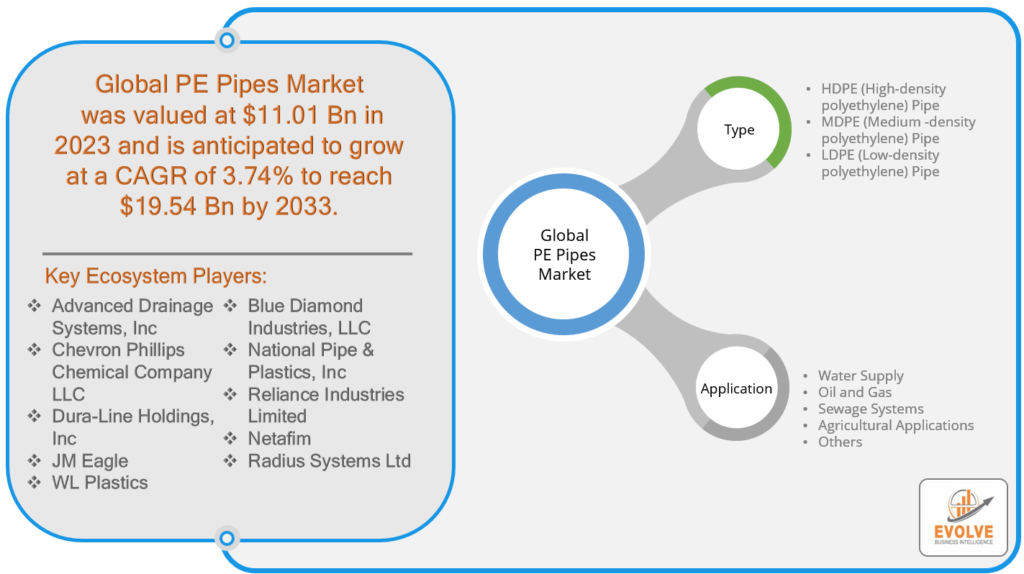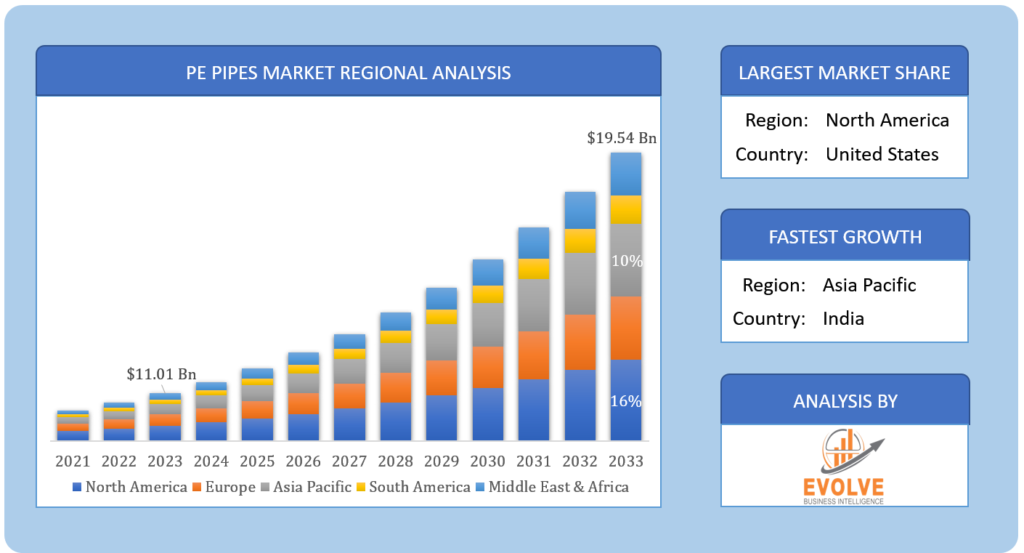PE Pipes Market Overview
The PE Pipes Market Size is expected to reach USD 19.54 Billion by 2033. The PE Pipes industry size accounted for USD 11.01 Billion in 2023 and is expected to expand at a CAGR of 3.74% from 2023 to 2033. PE pipes, or polyethylene pipes, are a type of thermoplastic piping system widely used in various applications for the transportation of fluids such as water, gas, and chemicals. These pipes are constructed from polyethylene, a durable and versatile polymer known for its excellent flexibility, corrosion resistance, and strength. PE pipes come in different grades and are suitable for both above-ground and buried installations. They are often preferred for their lightweight nature, ease of installation, and longevity, making them a popular choice in industries such as water supply, gas distribution, and irrigation. The flexibility and durability of PE pipes contribute to their ability to withstand external factors like soil movements and environmental stress, making them a reliable and cost-effective solution for fluid conveyance systems.
Global PE Pipes Market Synopsis
The COVID-19 pandemic had a multifaceted impact on the PE Pipes market. Initially, the market faced disruptions in the supply chain due to lockdowns, restrictions, and workforce challenges, leading to delays in production and distribution. However, as the pandemic highlighted the critical importance of sanitation and hygiene, there was an increased demand for PE pipes in applications related to water supply and wastewater management. Additionally, the surge in infrastructure projects, particularly in healthcare facilities and sanitation systems, further boosted the demand for PE pipes. The market also experienced shifts in consumer behavior, with a growing emphasis on reliable and durable piping systems, driving the adoption of PE pipes in various construction and industrial applications. Despite initial challenges, the PE Pipes market demonstrated resilience, adapting to new demands and emerging opportunities spurred by the evolving landscape shaped by the pandemic.
PE Pipes Market Dynamics
The major factors that have impacted the growth of PE Pipes are as follows:
Drivers:
Ø Growing Infrastructure Development
The increasing focus on infrastructure development, including water supply systems, agricultural irrigation, and gas distribution networks, acts as a significant driver for the PE Pipes market. The versatility, durability, and cost-effectiveness of PE pipes make them a preferred choice for various construction projects, contributing to market growth.
Restraint:
- Fluctuations in Raw Material Prices
Fluctuations in the prices of raw materials used in the manufacturing of PE pipes, such as polyethylene resins, can pose a restraint on the market. Price volatility can impact production costs for manufacturers, leading to challenges in maintaining competitive pricing and profitability in the PE Pipes market.
Opportunity:
⮚ Increasing Adoption of PE Pipes in the Oil and Gas Industry
The growing adoption of PE pipes in the oil and gas industry, particularly for applications like transportation of corrosive fluids and gas distribution, presents a significant opportunity for market expansion. The inherent corrosion resistance and durability of PE pipes make them well-suited for these demanding environments, opening new avenues for growth in the PE Pipes market.
PE Pipes Segment Overview
By Type
 Based on Type, the market is segmented based on HDPE (High-density polyethylene) Pipe, MDPE (Medium-density polyethylene) Pipe, and LDPE (Low-density polyethylene) Pipe. The HDPE (High-density polyethylene) Pipe segment in the PE Pipes market is poised for substantial growth throughout the forecast period, driven by the increasing demand for durable, corrosion-resistant piping solutions across diverse applications, including water supply, agriculture, and infrastructure development.
Based on Type, the market is segmented based on HDPE (High-density polyethylene) Pipe, MDPE (Medium-density polyethylene) Pipe, and LDPE (Low-density polyethylene) Pipe. The HDPE (High-density polyethylene) Pipe segment in the PE Pipes market is poised for substantial growth throughout the forecast period, driven by the increasing demand for durable, corrosion-resistant piping solutions across diverse applications, including water supply, agriculture, and infrastructure development.
By Application
Based on the Application, the market has been divided into Water Supply, Oil and Gas, Sewage Systems, Agricultural Applications, and Others. The Water Supply segment in the PE Pipes market is poised for substantial growth during the forecast period, attributed to the rising global emphasis on water infrastructure development and the increasing preference for durable and corrosion-resistant polyethylene pipes in water distribution systems.
Global PE Pipes Market Regional Analysis
Based on region, the global PE Pipes market has been divided into North America, Europe, Asia-Pacific, the Middle East & Africa, and Latin America. North America is projected to dominate the use of the PE Pipes market followed by the Asia-Pacific and Europe regions.
 PE Pipes North America Market
PE Pipes North America Market
North America has consistently maintained a dominant position in the PE Pipes market, underpinned by robust infrastructural development, stringent regulations promoting the use of corrosion-resistant and durable materials, and a burgeoning demand for efficient water management systems. The region’s advanced technology adoption, particularly in sectors like water supply, gas distribution, and telecommunications, has propelled the widespread application of PE pipes. Additionally, the growing focus on sustainable and environmentally friendly solutions aligns with the recyclable nature of PE materials, further driving their adoption. North America’s leading position in the PE Pipes market is characterized by a combination of established industry standards, ongoing infrastructure projects, and a sustained commitment to modernizing utility networks.
PE Pipes Asia-Pacific Market
The Asia-Pacific region has witnessed a rapid and remarkable surge in the PE Pipes industry, fueled by a confluence of factors including escalating urbanization, expanding infrastructural projects, and a heightened focus on efficient water and wastewater management. The region’s dynamic economic growth, particularly in countries like China and India, has driven substantial investments in construction and utilities, spurring the demand for high-quality, durable piping solutions. The versatility of PE pipes, offering resistance to corrosion, flexibility, and cost-effectiveness, aligns with the diverse needs of the burgeoning construction and agricultural sectors in the Asia-Pacific region. The increasing adoption of modern water supply and irrigation systems, coupled with a growing awareness of the benefits of polyethylene pipes, has positioned Asia-Pacific as a key player in the global PE Pipes industry.
Competitive Landscape
The Global PE Pipes market is highly competitive, with numerous players offering a wide range of solutions. The competitive landscape is characterized by the presence of established companies, as well as emerging startups and niche players. To increase their market position and attract a wide consumer base, the businesses are employing various strategies, such as product launches, and strategic alliances.
Prominent Players:
- Advanced Drainage Systems, Inc
- Chevron Phillips Chemical Company LLC
- Dura-Line Holdings, Inc
- JM Eagle
- WL Plastics
- Blue Diamond Industries, LLC
- National Pipe & Plastics, Inc
- Reliance Industries Limited
- Netafim
- Radius Systems Ltd
Scope of the Report
Global PE Pipes Market, by Type
- HDPE (High-density polyethylene) Pipe
- MDPE (Medium-density polyethylene) Pipe
- LDPE (Low-density polyethylene) Pipe
Global PE Pipes Market, by Application
- Water Supply
- Oil and Gas
- Sewage Systems
- Agricultural Applications
- Others
Global PE Pipes Market, by Region
- North America
- US
- Canada
- Mexico
- Europe
- UK
- Germany
- France
- Italy
- Spain
- Benelux
- Nordic
- Rest of Europe
- Asia Pacific
- China
- Japan
- South Korea
- Indonesia
- Austalia
- Malaysia
- India
- Rest of Asia Pacific
- South America
- Brazil
- Argentina
- Rest of South America
- Middle East & Africa
- Saudi Arabia
- UAE
- Egypt
- South Africa
- Rest of Middle East & Africa
| Parameters | Indicators |
|---|---|
| Market Size | 2033: $19.54 Billion |
| CAGR | 3.74% CAGR (2023-2033) |
| Base year | 2022 |
| Forecast Period | 2023-2033 |
| Historical Data | 2021 |
| Report Coverage | Revenue Forecast, Competitive Landscape, Growth Factors, and Trends |
| Key Segmentations | Type, Application |
| Geographies Covered | North America, Europe, Asia-Pacific, Latin America, Middle East, Africa |
| Key Vendors | Advanced Drainage Systems, Inc, Chevron Phillips Chemical Company LLC, Dura-Line Holdings, Inc, JM Eagle, WL Plastics, Blue Diamond Industries, LLC, National Pipe & Plastics, Inc, Reliance Industries Limited, Netafim, Radius Systems Ltd |
| Key Market Opportunities | • Growing Awareness of Environmental Sustainability |
| Key Market Drivers | • Rapid Urbanization and Infrastructure Development |
REPORT CONTENT BRIEF:
- High-level analysis of the current and future PE Pipes market trends and opportunities
- Detailed analysis of current market drivers, restraining factors, and opportunities in the future
- PE Pipes market historical market size for the year 2021, and forecast from 2023 to 2033
- PE Pipes market share analysis at each product level
- Competitor analysis with detailed insight into its product segment, Government and defense strength, and strategies adopted.
- Identifies key strategies adopted including product launches and developments, mergers and acquisitions, joint ventures, collaborations, and partnerships as well as funding taken and investment done, among others.
- To identify and understand the various factors involved in the global PE Pipes market affected by the pandemic
- To provide a detailed insight into the major companies operating in the market. The profiling will include the Government and defense health of the company’s past 2-3 years with segmental and regional revenue breakup, product offering, recent developments, SWOT analysis, and key strategies.








